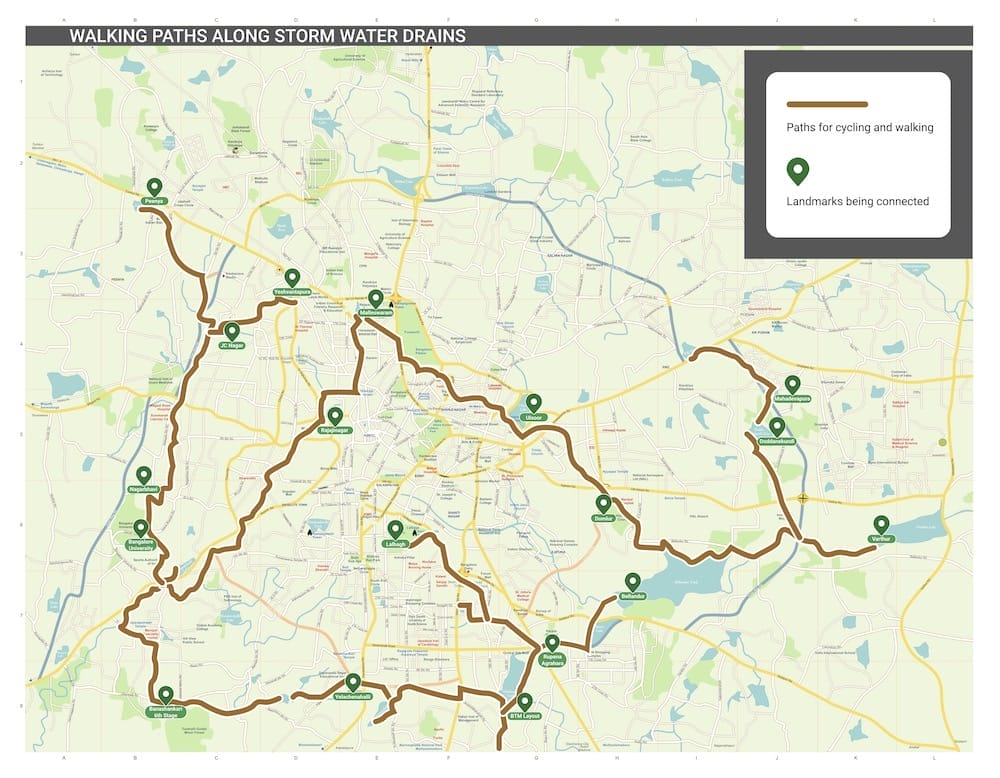Bengaluru has numerous parks and lakes, where we all love to walk and run. However, the city lacks proper walking, cycling, and running infrastructure. Daily walking for errands is nearly impossible due to broken sidewalks, exposed wires, and construction debris everywhere. Attempting to use a bicycle or run on the roads puts one at risk from heavy vehicles, cars, and other traffic.

Climate change and oft-repeated solutions
While the weather has traditionally been good, in recent years, due to climate change, it has been worsening. Summers have become unbearable, like this year when many of us endured the heat without fans or air conditioning. During monsoon months, roads flood almost every time it rains.
The solutions to these problems are well known. To prevent flooding, we should preserve lakes and avoid encroaching on storm water drains (rajakaluves or SWDs). These SWDs are not cleaned regularly and emit foul odours. The law mandates a 25-metre buffer zone on both sides of the SWDs, but these areas are frequently encroached. Due to lack of maintenance, flooding has become an annual occurrence during monsoons.
One of the solutions to address heat-related issues is to plant more trees. We also need shaded areas for outdoor workers to rest and hydrate. These facilities do not exist today.
Read more: Better mobility design can encourage the use of public transport, cycling and walking
An innovative solution: Green paths
What about an innovative solution that addresses the need to keep SWDs clean, creatively utilises buffer zones, and prevents encroachments?
The solution is to create green paths around these SWDs for walking, running, and cycling. Having a walking path will ensure that the SWDs are well maintained. Encroachments will be cleared to build these paths, which will also prevent future encroachments.
The cycling path should have a shaded area created by a solar roof. The path will allow runners, walkers, and cyclists to use it safely. It should have greenery on both sides, provide drinking water facilities, outdoor exercise equipment, and toilets (rest spots) at regular intervals, and should be cleaned frequently. The path will also connect various parks within the city and important urban areas.
I have consulted the SWD map of the city and created a draft map of the path. The route incorporates major SWDs I could identify in Bengaluru.

Similar projects are being built around the country. One example is the cycling path in Hyderabad. Look at the pictures from that path to imagine how it might look when built here. This post has good information about this cycling path.
Another advantage of this path is that it will create a walking, running and cycling highway for Bengaluru. People who want to travel to different parts of the city without dealing with traffic can use these paths to commute easily.
Runners who have complained about the lack of long-distance paths in Bengaluru can now run a full marathon of 43 km (or even an ultra of 50 km) solely on these paths.
This will also serve as a rest area during the day for people who work outdoors.
Read more: Guess why women avoid cycling in our city
Limitations
I can anticipate several challenges:
- These spaces are already encroached upon and will be difficult to clear
- There is a risk that these paths might be used by motorised vehicles
- The problem of stray animals (dogs, cows, buffaloes) will persist
- With regard to green paths around lakes:
- All walking paths are in a lake boundary
- No heavy construction, like a tarred or concrete road, should happen in a lake buffer zone
I feel that the SWDs are not maintained properly now because they are out of sight and out of mind. If we have a walking path next to a SWD, people will not allow it to be messed up. This is why I feel that having a walking path next to the SWD will ensure that it is always clean, stink free and clog free.
(This article has been republished with permission and a few updates)
Good dream about SWD. This will not happen,never. I created good Greenery with oxygen realising plant on SWD wire mesh. My unmindful neighbour destroyed it. No action from bbmp after complaining. God bless bbmp.
Great idea!
Great idea to be implemented with perseverance. We from Green Circle Bangalore are trying to revive & preserve krishasagar lake & Avalhalli lake near Prestige Royale Gardens. We have partially implemented the above suggestions.